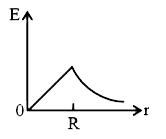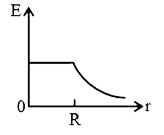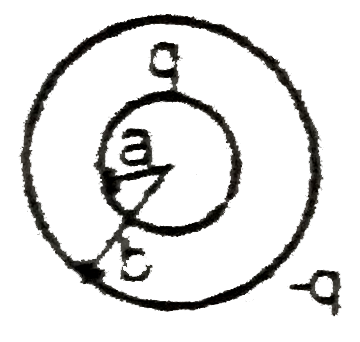For a uniformly charged non conducting sphere of radius R which of following shows a correct graph between the electric field intensity and the distance from the centre of sphere –




The correct Answer is:A
To solve the problem of determining the correct graph between electric field intensity and distance from the center of a uniformly charged non-conducting sphere, we will analyze the electric field both inside and outside the sphere step by step.
Step 1: Understanding the Problem
We need to find the relationship between the electric field intensity (E) and the distance (r) from the center of a uniformly charged non-conducting sphere of radius R.
Step 2: Electric Field Inside the Sphere
1. Define the Gaussian Surface: For a point inside the sphere (r < R), we consider a Gaussian surface that is a sphere of radius r, concentric with the charged sphere.
2. Calculate the Charge Inside: The charge enclosed by this Gaussian surface can be calculated using the volume charge density. If the total charge of the sphere is Q, the charge inside the Gaussian surface is given by:
Qinside=Q⋅Vsmall sphereVlarge sphere=Q⋅43πr343πR3=Q⋅r3R3
3. Apply Gauss's Law: According to Gauss's law, the electric flux through the Gaussian surface is:
Φ=E⋅4πr2=Qinsideϵ0
Substituting for Qinside:
E⋅4πr2=Q⋅r3R3ϵ0
4. Solve for Electric Field (E): Rearranging gives:
E=Q4πϵ0R3r
This shows that the electric field inside the sphere varies linearly with r.
Step 3: Electric Field Outside the Sphere
1. Define the Gaussian Surface: For a point outside the sphere (r > R), we consider a Gaussian surface that is a sphere of radius r.
2. Apply Gauss's Law: The total charge enclosed is still Q. Thus, the electric flux through the Gaussian surface is:
Φ=E⋅4πr2=Qϵ0
3. Solve for Electric Field (E): Rearranging gives:
E=Q4πϵ0r2
This indicates that the electric field outside the sphere varies inversely with the square of the distance from the center.
Step 4: Summary of Results
- Inside the Sphere: E∝r (Electric field increases linearly with distance)
- Outside the Sphere: E∝1r2 (Electric field decreases with the square of the distance)
Step 5: Graph Interpretation
- The graph of electric field intensity vs. distance from the center will show a linear increase for distances less than R and a decrease proportional to 1/r2 for distances greater than R.
Conclusion
The correct graph will start from the origin, increase linearly until it reaches the radius R, and then drop off as 1/r2 for distances greater than R.
We need to find the relationship between the electric field intensity (E) and the distance (r) from the center of a uniformly charged non-conducting sphere of radius R.
1. Define the Gaussian Surface: For a point inside the sphere (r < R), we consider a Gaussian surface that is a sphere of radius r, concentric with the charged sphere.
2. Calculate the Charge Inside: The charge enclosed by this Gaussian surface can be calculated using the volume charge density. If the total charge of the sphere is Q, the charge inside the Gaussian surface is given by:
Qinside=Q⋅Vsmall sphereVlarge sphere=Q⋅43πr343πR3=Q⋅r3R3
Φ=E⋅4πr2=Qinsideϵ0
Substituting for Qinside:
E⋅4πr2=Q⋅r3R3ϵ0
E=Q4πϵ0R3r
This shows that the electric field inside the sphere varies linearly with r.
1. Define the Gaussian Surface: For a point outside the sphere (r > R), we consider a Gaussian surface that is a sphere of radius r.
Φ=E⋅4πr2=Qϵ0
E=Q4πϵ0r2
This indicates that the electric field outside the sphere varies inversely with the square of the distance from the center.
- Inside the Sphere: E∝r (Electric field increases linearly with distance)
- Outside the Sphere: E∝1r2 (Electric field decreases with the square of the distance)
- The graph of electric field intensity vs. distance from the center will show a linear increase for distances less than R and a decrease proportional to 1/r2 for distances greater than R.
The correct graph will start from the origin, increase linearly until it reaches the radius R, and then drop off as 1/r2 for distances greater than R.
Similar Questions
The electric field intensity at a distance 20cm from the centre of a uniformly charged non conducting solid sphere of radius 10cm is E.Then what is the electric field intensity at a distance 5cm from the centre it will be.....
View SolutionA conducting sphere of radius R is charged to a potential of V volts. Then the electric field at a distance r(>R) from the centre of the sphere would be
View SolutionA conducting sphere of radius r has a charge . Then .
View SolutionFigure shows two concentric shells of radii a and b uniformly distributed charges q and -q. Which of the following graphs gives correct variation of electric field intensity E with the distance r from the centre?

View SolutionA non-conducting solid sphere of radius R is uniformly charged. The magnitude of the electric filed due to the sphere at a distance r from its centre
View SolutionThe electric field at 2R from the centre of a uniformly charged non - conducting sphere of rarius R is E. The electric field at a distance R2 from the centre will be
View SolutionAt a point 20cm from the centre of a uniformly charged dielectric sphere of radius 10cm, the electric field is 100V/m. The electric field at 3cm from the centre of the sphere will be
View SolutionAn isolated solid metal sphere of radius R is given an electric charge. The variation of the intensity of the electric field with the distance r from the centre of the sphere is best shown by
View SolutionFigure shows a uniformly charged thin non-conducting sphere of total charge Q and radius R. If point charge q is situated at point 'A' which is at a distance r<R from centre of the sphere, then find out following :
(i) Force acting on charge q.
(ii) Electric field at centre of sphere.
(iii) Electric field at point B.

View SolutionWhich one of the following graphs represents the variation of electric field with distance r from the centre of a charged spherical conductor of radius R?
View Solution
